 |

Daigo, episode 1
A monthly column by Pieter Mioch featuring a thorough
game commentary tastefully seasoned with go-related
stories and clues to the meaning of life.
About the Title: DAIGO (or TAIGO) can be translated
as "enlightenment". I adopted it, however, because
of the proverb, "Taigi wa Taigo no Motoi" which, in
English, reads, "Great Doubt is the Beginning of Great
Enlightenment." By the way, I'm not allergic to it or
anything but this word, enlightenment, often gives me
goose bumps, I don't know why. So, lets simplify the
proverb to, "If you never question anything, you won't
get very far."
Introduction
When writing "Gentle Joseki", I often felt I was running
down a summery field full of breathtaking butterflies
of all shapes and sizes. Blundering through knee-high
grass, tightly holding my net with both hands, I was
trying to catch as many of the winged creatures as
possible. After every attempt I would find out that I
only caught some lesser species, although these had nice
colors too.
At times I caught a satisfying quantity, but was unable
to describe them in proper language; at other times, I
only caught one or two, but I could explain them better,
even if I did worry about boring the reader.
Whether or not I caught all this go-wisdom fluttering
and flying around my head, I would always, eventually,
end up alone again; between truckloads of weeds and just
a few flowers. The thing to do was to search the horizon
for a "butterfly nest" and kick it a bit to see if any
new butterflies would emerge.
In "DaiGo", I will not desperately hunt anything.
Neither will I do a lot of running around. The game
analyses will deal with virtually *every* move played
and the going will be slow. If people start complaining
I might want to reconsider this, but, for now, I'll set
off at a pace of something between 10 and 30 moves per
DAIGO episode.
Pro Talk
The other day I was hanging around and killing time with
Shimojima and Miyagawa, both 6 dan pros. If there's one
thing you should brush up on to prepare your self for a
trip to Japan it is this "hanging around". Everyone I
have ever met here is very good at it, and the go insei
and professionals are no exception. Actually, I think
they're exceptionally good at chewing the fat (what
a remarkable expression) while waiting for something
to happen. If nothing happens then eventually someone
will be forced to leave to give go lessons somewhere;
this can take anywhere from 10 minutes to 3 hours or
more. Anyway, listening to the conversation it seemed
that Yumi Hotta (who by now can buy a house with the
royalties for her successful manga creation "Hikaru no
Go") had called Shimojima and asked, bluntly, "How many
games can a professional simultaneously rig so black
wins every game by exactly one point?"
Shimojima, six years the younger, was asking Miyagawa
(29) politely for his opinion. "How about it, Sensei? I
had no idea what to tell Mrs. Hotta and I promised to
call her back." Miyagawa: "It's an impossible question,
good luck with it."
"But I have to tell Mrs. Hotta something, don't I?"
Miyagawa: "Look, the problem is that you only can rig
a game so closely if the amateur(s) in question play
reasonably well. It is unbelievable if you seriously
start calculating how many points some people just throw
away in the endgame. There's no way on earth, short from
filling in your own territory and other less subtle
methods, that you can precisely determine the outcome
when playing against the wrong person. If you really
want to, you can tell Mrs. Hotta that 3-4 games must be
doable, but I for one would never bet my life on it, not
if it has to look real."
"Yeah, that makes sense, I guess the 3-4 game number was
probably what she was hoping for. I'll just tell her
that."
Now, don't get me wrong. At no moment was either
Shimojima or Miyagawa speaking with contempt for weaker
players. This is just a good example showing that many
amateurs, Mrs. Hotta included, think that professional
players are a step closer to god and that they pretty
much know everything about anything. Nothing could
be further from the truth. Aside from extraordinary
fighting skills, a lot of pros often have no clue about
the whys and hows; they just don't show it. After all,
that's what they get paid for. By the way, I'm not
talking about the world's top ten players, of course.
On another, later occasion, when I was hanging around
again, keeping Miyagawa company, we came to talk about
talent. Miyagawa surprised me big time and turned out to
be a self-made philosopher. "Talent" he said,
"the only talent I believe in is the ability to
persevere in one's studies."
The Game
An e-mail match played over a 4 month period between an
up-and-coming European 5-dan and myself.
The diagrams below are printed in two colors, one for the actual
game and one for the explanatory diagrams and side-tracks, as follows:
Perfect Harmony |
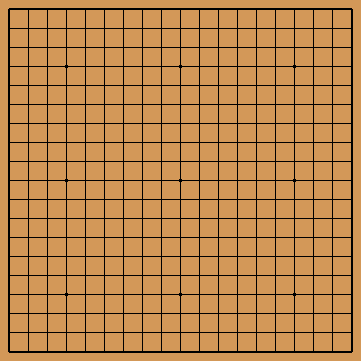 |
There it is again, an empty board, isn't it beautiful?
Unfortunately you are going to have to intrude on this
perfect harmony. It's your move and whether you look at
Go as a contest between two people, between two minds, a
fascinating way of sharpening your mind, or a cool way
to have fun, you have to get started eventually.
|
Game Diagram 0 |
|
|
|
Right now, I will give you the most important and useful
piece of advice for dealing with the opening stage of
the game. Once you know this you might as well skip the
analyses and move on to the middle game. You would miss
out on a lot of stuff but I mean it when I say that this
sentence below is the essence of fuseki:
At your first move(s), please, and by all means,
do not have a plan.
Keep loose, be relaxed and play any move you like, a
move you like. Trying moves you saw stronger
players make is good. Going your own way and playing
whatever you feel like is better. Combining the two is
best. Try to remember a bit about what happened and use
that information in your next game.
"But I want to try this or that opening," you say. "But
I want to try this wonderful trick joseki," you say.
Well, great, way to go, but aren't you forgetting that
this game is played with two people? If you get
a chance to do everything you planned before touching
the first stone, go ahead, but never, ever, try to force
your ideas on your opponent, regardless of what they
are doing. A plan is the worst thing possible, it kills
the open-mindedness that is the most powerful and most
essential thing you need to counter and adapt to your
opponent's every move.
So, right from the start with your first move, you're
going to play what you like, because you want to see the
look on your opponent's face when you play at the 6-6
point, or because you just feel down and want to play at
the 3-3 point.
You've just learned how to double your appreciation of a
game of go and, if you can implement the above, I'm sure
you'll be playing two stones stronger within a week.
Are there any rules about where black should play
his first move?
Upper Right |
 |
It's not a strict rule but, most of the time, you will
see people, pros and amateurs alike, play their first
move in the upper right corner. Playing one of the
squared marked points is considered good manners, but
nobody will probably say anything if you flout it. The
leading Japanese pro Yoda did this once in a match game,
however, and the newspapers were stunned.
|
Diagram 2 |
|
|
|
There are many more useful things to think about,
concerning your first move (don't think of naked fantasy
objects, don't just throw your stone anywhere on the
board); but it's time to show you the first move of the
game, of my game.
I hate writing, "I did this because..." or
"My opponent did not realize that...",
so, if you don't mind I will just discuss the game in the black
player - white player format. This game started at
9:36:30 o'clock, on May 4, 1999. The average playing
speed was about one move per day.
The First Move |
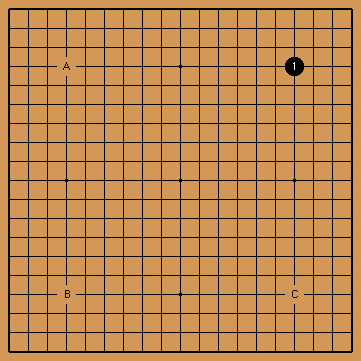 |
Black's first move was at the 4-4 point, also called
"hoshi". These days, I have the distinct feeling that
the perfect first move for black is not somewhere on
the third line, but not on the forth line either.
Although it makes the game difficult right from the
start, for the person who tries it, I think that the
ideal first move is closer to the middle of the board
than commonly thought. A play on the fifth or even sixth
line might come in extremely handy when doing some whole
board fighting. Almost nobody plays moves at such high
altitudes because if there's no fighting at all, the
lower a stone is (3rd or 4th line), the more efficiently
it can be put to use to secure territory. A play on the
sixth line might as well not be there at all, strictly
speaking, in terms of the likelihood of a move making
territory.
|
Game Diagram 1 |
|
|
|
Now, what should white be thinking to play his first
move of the game? Are there many things to consider
before deciding to play in corner A, B or C?
The person who manages to ponder over whether to take
corner A or C will almost certainly not be able to
finish a game of go in less than two hours. Which is
not to say that, if it were my turn, I would actually
seriously think about A or C. My winning percentage of
recent games in which I played either move deserves
brief consideration.
There are books and theories about the second move of
the game being the losing move, but frankly I don't buy
it. The beautiful thing about the opening or fuseki
stage of go is that no living being knows exactly what
and how it works. This explains why there are tons of
best-selling books written by professional players about
the opening; they are often different but all claim
to be correct. Well, as long as the book is actually
written by a pro, of course, they are telling the truth,
or at least a part of it. The bad thing about the truth,
though, is that there is so much of it! Most books I
glance through (they have a huge and up-to-date go book
collection at the new library here) dealing with fuseki
eventually end up showing rather down to earth joseki
to demonstrate that this or that is good or bad. It
seems that the author, pros to be sure, are extremely
reluctant to go out on a limb and seriously discuss
far-out strategies. Even the latest Korean books are
dealing with new patterns of standard opening/joseki
moves.
Don't Worry |
 |
As long as I don't see any books telling why white 2
is a bad move and also provide irrefutable proof that
the white 2 - black 3 exchange is bad for white, I will
certainly not believe that white should worry about
their first move being a a "losing" move. I do advise
you, however, to stay off the first line.
|
Diagram 3 |
|
|
|
Having said all this, there are, of course, things you
might want to consider before playing white 2.
a Matter of Choice |
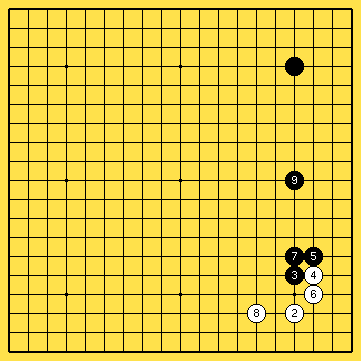 |
When white chooses to play at 2 as shown here, one
likely possibility, at some point in the opening, could
be the joseki up to 9. This gives white territory
and black gets a nice moyo-like (potential territory
framework) formation. In other words, if you don't like
a game where sure territory fights against a moyo,
then white 2 (and the joseki up to 8) is perhaps an
unfortunate choice, though never a losing choice.
|
Diagram 4 |
|
|
|
Is pincering a good strategy to thwart black's moyo?
No Black Moyo? |
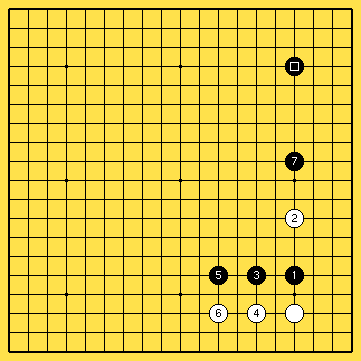 |
The pincer of white 2 seems to let go of the idea of
making territory and instead tries to prevent black
from making anything like a framework. After black 7,
however, black's marked stone is in a nice position.
| Diagram 4a |
|
|
|
Moyo versus Territory |
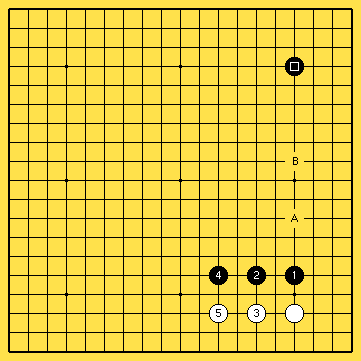 |
This is exactly the same position as dia 4a. The only
difference is that I took away a white stone and a
black stone. Can you see that white is the one going
for the low, solid territory and that black is busy
making a moyo? Funny, isn't it, how you can sometimes be
positive that you're doing something else, preventing a
certain situation from occurring, but after the smoke
has cleared it turns out the opposite!
|
Diagram 4b |
|
|
|
By the way, white's reduction of this moyo by playing A,
and black's counter at B, is definitely not the first
thing that comes to mind, and I can't imagine white
being happy with it.
Letting Go of the Corner |
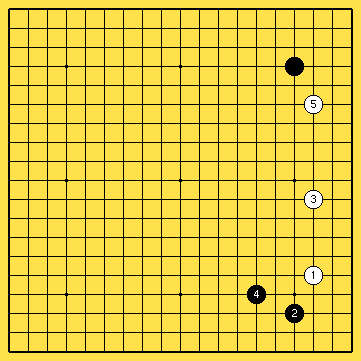 |
On the other hand, if white plays at the 5-3 point as in
dia 5 (or at the 5-4 point) it is much more likely that
the right side of the board will become white's sphere
of influence. I'm not saying that things will definitely
develop as in dia 5. Entering the corner with black 3,
however, is a very natural move, which easily sets in
motion a sequence leading to dia 5 or something similar.
|
Diagram 5 |
|
|
|
Diagonal Opening |
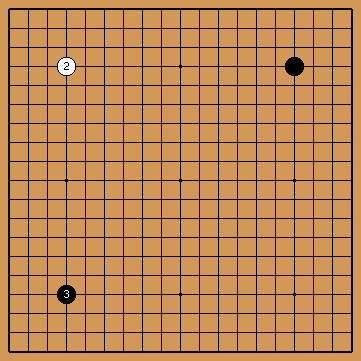 |
White 2 at hoshi in the upper left corner leaves black
the opportunity to play a diagonal opening, thus
reducing the likelihood that this will become a game of
big moyos, each player claiming half the board. Note
that after black 3, neither player has made any sure
territory yet; they prefer to develop their stones
quickly, playing high at 4-4 instead of playing low and
tight. Usually in a game like this the points exactly
in between the corner hoshi (side hoshi?) are extremely
valuable.
|
Game Diagram 2 |
|
|
|
Black is doing O.K. |
 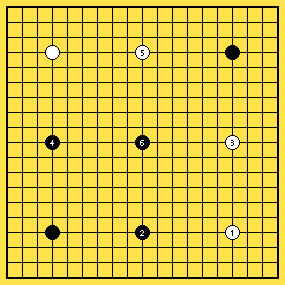 |
|
Something tells me that dias 6 and 6a are both better
for black; it feels as if black 6 is worth more than the
standard komi (compensation for the first move of 5.5
points). This kind of opening pattern always reminds me
of the New Fuseki period of the 1930s and the original
Chinese way of playing, in which the first 4 moves or so
were always the same, the diagonal hoshi, as decided by
the rules.
|
Diagram 6 & 6a |
|
|
|
Some while ago, I read that Bobby Fischer, the Lee Chang
Ho of chess of the 1970s, suggested alternative chess
rules in which the opening situation of every game is
different and decided at random. Perhaps in the future
go will also be played like this, although it seems hard
to believe now. It would, however, force players to get
away from their favorite patterns, an idea that seems to
have some merit, and one that might stimulate players to
think more than they have up until now.
To get back at the game, white has one empty corner
left to occupy, and there does not seem to be any
particularly good or bad move. As white you now have the
option of choosing between being approached (which black
certainly will do if white plays at the 4-3 point), or
approaching (if white plays at the 5-3 or 5-4 point,
black will usually enter the corner, getting the same
result as if black played in the corner first, white
played an approach move, and black ignored him and
played elsewhere).
White can, of course, play at the 4-4 or 3-3 point in
the remaining corner, which tends to lead to (locally)
shorter and perhaps simpler ways of playing.
Mind you, a move at the 4-4 point can lead to very
complicated fighting and is by no means an "easy" move.
The relatively easy move is the 3-3 point.
Aquarium Ornament? |
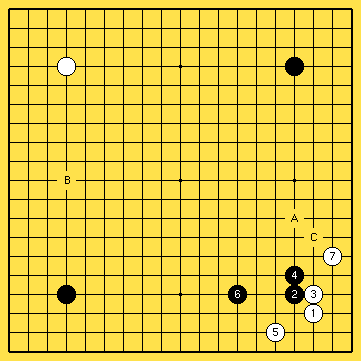 |
After white 1 at 3-3, black 2 is one of the first moves
that comes to mind. This keeps white low and builds
"something" towards the center. After white 7, black
A is often seen. Playing elsewhere, for example at B,
is also possible. Black C is an overplay; black cannot
expect white to just crawl along the second line. Black
C will lead to a fight because white will push through
and cut without second thoughts. If you don't show your
opponent that you have fangs, from time to time, he'll
be walking all over you in no time and use your head as
an ornament to put in his aquarium.
|
Diagram 7 |
|
|
|
Approaching is Natural |
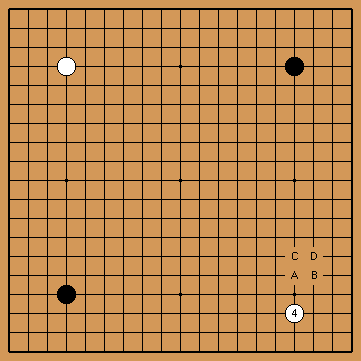 |
White played at ko-moku with his second move; black's
next move can be expected at A, B, C or D. If black
approaches at A, something like dia 4 might entail.
After a black approach move at B, white can extend
along the bottom, although this feels a bit old-fashioned.
Alternatively, he can play a pincer at the right side.
|
Game Diagram 3 |
|
|
|
A Game from 1982-05-13 |
 |
Black: Sato Masaharu, 7p
White: Ishida Akira, 8p
Result: B+Resign
A fuseki (opening) as common as they come. Any person
who has been playing for a couple of months could get
this on the board. After black 13 the "traditional"
moves are A, B and C, while D and E are more modern and
extremely popular nowadays.
|
Diagram 8 |
|
|
|
Cho and Kobayashi |
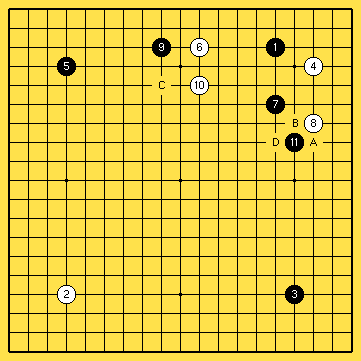 |
Date: 1992-05-27,28
Event: 47th Honinbo title
Black: Cho Chikun
White: Kobayashi Koichi
Result: W+Resign
Here, black 9 is very nice with the back up of the black
hoshi in the upper left corner. Instead of making a moyo
(not something Cho is famous for) with a black follow-up
move at C or D, black chooses to get out his old, spiked
glove and slap it in white's face as a challenge. For
white, going along with black and playing at A is not
bad. During the match, however, it seems likely that the
tense atmosphere in the playing room would have spoken
for itself. The almost-palpable feeling coming from the
contestants that says,
"I'm not going to give you an inch if I can help it. I'm
going to be at your throat at every chance, and you had
better be ready."
White pushed through and cut, and difficult fighting followed.
|
Diagram 9 |
|
|
|
It would be nice if somebody could check if any game
records survive of games between these two Japanese go
giants when they both were "only" students at the school
of master Kitani. Cho and Kobayashi have met each other
in so many different arenas and have played so many
extremely intense matches that I guess they must feel
part of each other by now.
A Distant Approach Move |
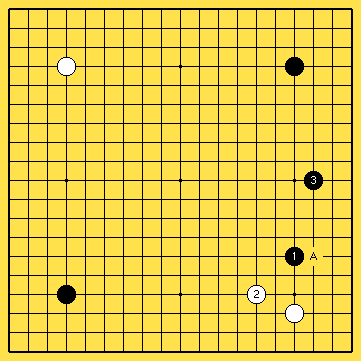 |
Black 1 here is more or less in the same spirit as a
move at A. With either move, it is less attractive for
white to play a pincer since the black approach move is
at close to the white corner stone. Any pincer white
might play would not have a great impact on black.
|
Diagram 10 |
|
|
|
An Unexpected Turn |
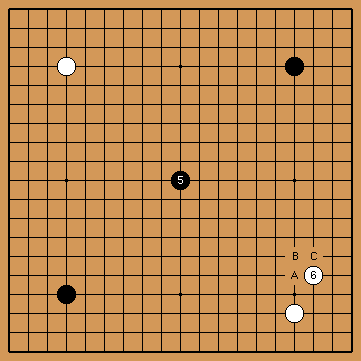 |
Black 5 was a move nobody expected, and it's not seen
often. I think black is more concerned with trying
something different than anything else. Black will have
a hard time making the tengen stone come out nicely and
this can be expected to become the focus of the game.
White 6 is only natural, not hurried, and playing a
tight game, waiting to see what black is going to do.
|
Game Diagram 4 |
|
|
|
One thing you should realize when talking about tengen
is that this play is not about trying to make territory
in the middle of the board. This can easily be seen
below:
Wasted Move |
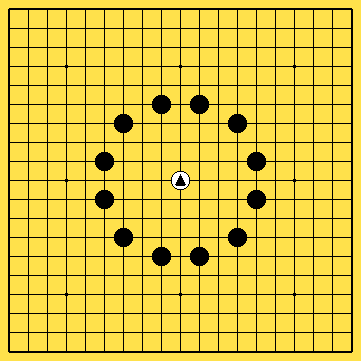 |
You won't see this kind of shape in your own games very
often. But, now that you have it in front of you, it is
obvious that a black play on the triangle spot would
be a wasted move. It is not necessary to defend this
territory. If you really want to do something in the
middle, a move at the 14-9 point looks better.
|
Diagram 11 |
|
|
|
This is not to say that black cannot put his tengen
stone to good use when making a large territorial
framework, a moyo. Takemiya's games of the 80s are
a very good example of how to make huge side/center
oriented territory. I still, however, would like you to
only think about the possible territory one can make
with a tengen stone as an afterthought and not a prime
directive.
Go Seigen Game |
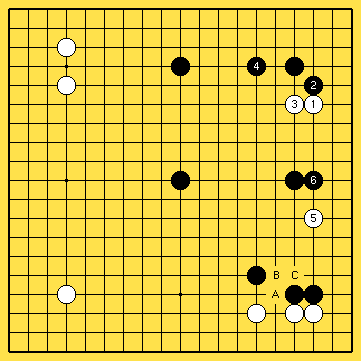 |
Date: 1962-06-27,28
Black: Hashimoto Utaro
White: Go Seigen
Result: W+7 pnt.
This is the right spirit. Black played his first move
at tengen and is threatening to make over a third of
the board his. White has often little choice when this
occurs, and, as can be seen in the game example, white
invaded black's sphere of influence. The only thing
black needs to be careful about is that the weak white
stones don't easily link up or make eyes. Ideally
speaking, the only thing left for white would be to jump
out and try to escape or make eyes in the center of the
board, and voila, there is black's tengen stone exactly
at the right spot!
|
Diagram 12 |
|
|
|
Well, white wasn't born yesterday and he (being Go
Seigen), of course, had read out this whole scenario;
he probably invented it himself. After black 6, white
played A, black B and white cut at C. White then had
to sacrifice a couple of stones, but he quite neatly
succeeded in making a living group inside black's moyo
while leaving tons of aji to look forward to.
I'm in love with many moves of this amazing game and the
tengen play is certainly one of them. Putting it to good
use is often difficult, but playing against a tengen
opening is no piece of cake either.
Poetic License |
 |
Yesterday I was in Gifu, and I had a chance to put this
on the board at the pro study group. Since most of the
pro were finished, and it was still too early to start
playing Mah-Jong, they were willing to kick it around a
bit.
To make a long story short, "Er, that does not compute,
not enough information, er, does not compute, not ..."
That was the general opinion. The tengen stone
changes a lot of the normal ways of thinking about
fuseki. Having played an early move right in the middle
of the board seems to give black a kind of a poetic
license. Now, he has all kinds of (crazy) options, and,
although the pro's were giving it some serious thought,
it is way too early to decide on *the* best next move.
Everything depends on the continuation, and a rigid
state of mind here would be dangerous. To show a couple
of the follow-up moves discussed, those at or around A,
B, C and D all look playable.
|
Game Diagram 5 |
|
|
|
Remember, it's how you use available troops that counts;
their location is but a minor detail.
(I'm sure some dead general said this at one time or
another, the argument which followed with his troops
doing him in.)
Over-Extension |
 |
Black chose to play the over-extension of 7. If this
move were more to the left, white could still consider
an extension from his shimari to the left of A. Now,
however, A is too tight, and if white plays here, black
will probably switch to somewhere around B. This will
leave white a little low, and black racing to grab all
the big points.
|
Game Diagram 6 |
|
|
|
White probably did not play an approach move at C
because he didn't like the prospect of being pincered at
D. This way of playing seems to make the black stones
come out nicely.
Tengen Looks Nice |
 |
It is not as if white's way of playing is wrong or bad.
The point is that the black tengen stone looks a kind of
natural, sitting there right in the middle of the board,
and is doing a good job of setting up a huge moyo.
|
Diagram 13 |
|
|
|
Black Not So Happy |
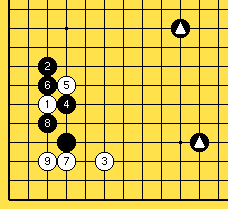 |
White can try to initiate the fashionable joseki shown
in dia 14. The end result is not to black's liking, and
his triangle-marked stones are not very effective.
|
Diagram 14 |
|
|
|
Black Happy |
 |
Black, however, will walk away from the joseki in
dia 14. He will certainly not play it just because
it happens to be the latest trend. Black will play a
very simple and older joseki as shown in dia 15. After
white 9, black can choose to play "honte" (proper
reinforcement) at A, B, C and sometimes D.
|
Diagram 15 |
|
|
|
White's next move seems to be part of the psychological
warfare that more often than not takes place when two
players meet each other at the go board, right from the
"Have a nice game" at the beginning.
Entering the Dragon? |
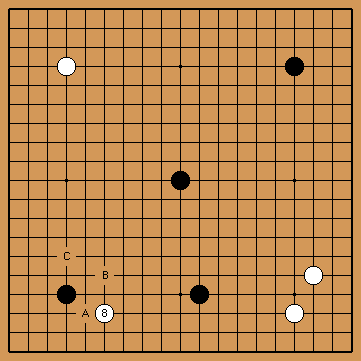 |
White 8 is a kind of "in your face" move. It is, as we
saw, by no means the only point on the board. White,
however, was probably concerned about a possible black
moyo because of the presence of the tengen stone. So,
before any kind of moyo can materialize, white enters
early, seemingly confident that while he's playing in
what looks like a black stronghold he'll be able to
easily settle his stone(s).
|
Game Diagram 7 |
|
|
|
Just to mention some possible replies, black A, B and C
all look common. Black B is the move to play if black
wants to continue building his moyo.
Black Is Not Complaining |
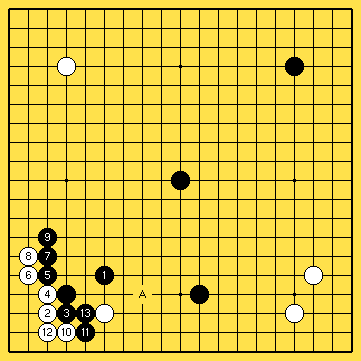 |
If white enters at the 3-3 point, something like dia 16
could occur. This is very much to black's liking and it
seems that white has to come up with something else.
Instead of the 3-3 point, jumping to A looks better,
but, even so, black is not complaining.
|
Diagram 16 |
|
|
|
Playable as Well |
 |
Because of the presence of the marked black
stone, playing a pincer with black 1 is often judged too
tight or over-concentrated. This might be clearer if the
marked stone were one space to the left, but, in its
current position it is playable, although my guess is
that many players would prefer the marked stone to be at
least as far as A
|
Diagram 17 |
|
|
|
Balance of Power |
 |
The sequence from black 9 to white 12 looks very much
like a textbook example. Usually black is reluctant to
make the black 9, white 10 exchange, because his corner
is still vulnerable, and white can easily invade later
at the 3-3 point. The reason for black 9 is to prevent
white from sliding in at A. And, because of the marked
black stone, white cannot extend further than 12, which
leaves him one point short of the optimal extension. Of
course, white read out this possibility and he doesn't
mind it too much. White's strategy is to single out the
marked black stone and try to shift the balance of power
at the lower part of the board. Whether this is a good
idea or asking for too much, because of the "extra"
black stone on tengen, remains to be seen.
|
Game Diagram 8 |
|
|
|
Hanging on to the Corner |
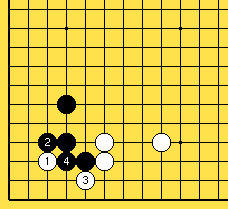 |
The invasion at the 3-3 point is not likely to happen
any time soon; it is too small. In the future, however,
white will be aiming at playing here. If black wants to
keep as much of the corner territory as possible, dia 18
is probably best.
|
Diagram 18 |
|
|
|
Sealing White In |
 |
Black can also choose to strengthen himself in "sente"
(while holding the initiative) as shown in dia 19.
Instead of 5, white could play at 6, after which black
usually pushes through and cuts. (Remember this from
Gentle Joseki? Cut at the side you don't want.)
|
Diagram 19 |
|
|
|
Next move? |
 |
Next move problem. The pros unanimously choose one move
as the most natural, two moves as "possible" (not good,
not bad, everything depends on the continuation) and one
move they did not mention at all.
|
Diagram 20 |
|
|
|
Determine how the pros evaluated the moves A, B, C and
D, and find out the answer in the next episode of DAIGO.
Credits
Many thanks go to:
Kirk McElhearn,
for proofreading (the text was perfect when I send it out,
any mistaces you vind ar kunningly insertet bye heem).
John Fairbairn,
for telling me about the "Records of Great Doubts" by Zhu Zi
and the origin of the Japanese "daigo/taigo".
Jan van der Steen,
for checking and adjusting the html and putting up (with me) my stuff.
[Daigo 1]
[Daigo 2]
[Daigo 3]
[Daigo 4]
[Daigo 5]
[Daigo 6]
[Daigo 7]
Copyright by
Pieter Mioch, August 2001
| |

































